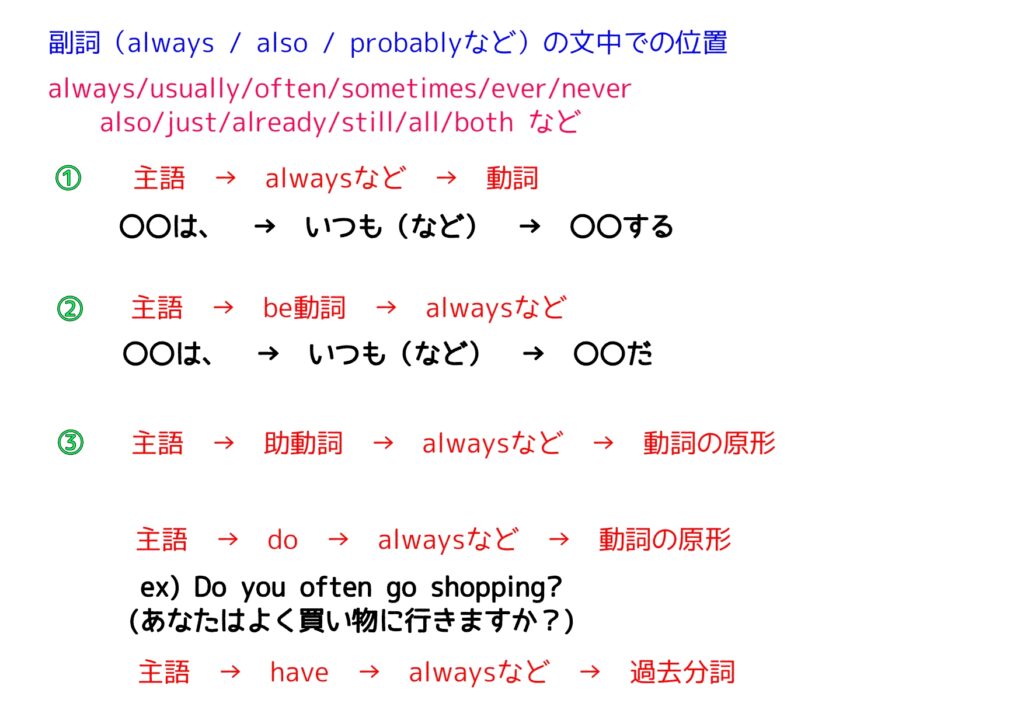第74回:副詞を使うタイミング

文中において、副詞はどの場所にあるのかを確認してみましょう。
Q. この記事で、一番大事なことって何?
A. 大事なことを、1枚の画像にまとめました。

いちいちノートにまとめるのが面倒だという方、また、
ノートにまとめることが苦手だという方は、ご活用ください。

[広告]
確かな英語力は、日々の継続から。
その継続を後押しする、第二言語習得理論に基づいた
オンライン英語学習プログラムがあります。
英語を使う人のための、確実なスキルアップが望める
7日間の無料体験はこちらから!

副詞の位置は、前・真ん中・後ろのどれか。
副詞の位置には3つ、主な位置があります。それは、後ろの位置、前、そして中間です。
- 終わりの位置(End position)
終わりの位置では、副詞は動詞の後に来ます。それは、直後であるか、文の後の方であるかによって異なります。
例えば、「They played quietly all day.」(彼らは一日中静かに遊びました)や「He tried to leave quietly.」(彼は静かに出ようとしました)、「He sat in the corner quietly.」(彼は静かに隅に座りました)。 - 前置位置(Front position)
前置位置では、副詞は主語の前に来ます。
例えば、「Finally he could stand the noise no longer.」(ついに彼はもうその騒音に我慢できなくなった)や「Sometimes I feel like leaving.」(時々、私は出発したいと感じます)といったようにです。 - 中間位置(Mid position)
中間位置では、副詞は主語と動詞の間に来ます。具体的には、be動詞の直後、または最初の助動詞の後に配置されます。
「She is usually here by ten.」(彼女は通常、10時までにここにいます)や「They would usually come by car.」(彼らは通常、車で来る)といった例があります。
多くの副詞は、文脈やスタイルに応じてこれらの位置のどれかに配置することができます。例えば、「He turned round slowly.」(彼はゆっくりと振り返った)、「Slowly he turned round.」(彼はゆっくりと振り返った)、「He slowly turned round.」(彼はゆっくりと振り返った)。
さらに詳しく説明するために、以下の要点を紹介します。
- 終わりの位置では、通常、副詞を動詞の直後ではなく、目的語の後に配置します。ただし、目的語が非常に長い場合は、他の位置に配置することも可能です。
- 主動詞と後続の動名詞または不定詞の間には副詞を挟みません。
- 副詞の位置は文の意味を変えることがあります。注意が必要です。
- 終わりの位置に複数の副詞がある場合、一般的な順序は方法(何をどのように行ったかを示す)、場所、時間です。特に強調する場合は、副詞を文の終わりに移動することもできます。
- 副詞は、同じ機能を持つ前置詞句の前に来ることが一般的です。
- 終わりの位置は、場所や明確な頻度、明確な時間の副詞にとって一般的です。しかし、不特定の時間の副詞は通常、中間位置に配置されます。
- ジャーナリズムでは、他の時間の副詞は通常、終わりの位置(または前置位置)に配置する場所に置かれることがあります。
以上のように、副詞の位置は文の構造や意味に影響を与える重要な要素です。正確な位置の選択は、明確なコミュニケーションとスタイルの鮮明さを確保するために注意が必要です。
具体例
- End position:
- She ate the cake greedily.
- He solved the puzzle effortlessly.
- They danced all night.
- We traveled extensively last summer.
- End position with object:
- He painted the wall meticulously.
- She cleaned the house thoroughly.
- They discussed the issue briefly.
- We examined the evidence carefully.
- Avoiding adverbs between main verb and -ing form/to-infinitive:
- He started singing loudly.
- She enjoys reading books silently.
- They decided to leave early.
- We plan to visit the museum tomorrow.
- Changing meaning with different positions:
- She openly criticized his decision. (She criticized his decision openly.)
- They accidentally bumped into each other. (They bumped into each other accidentally.)
- He quickly fixed the broken chair. (He fixed the broken chair quickly.)
- Order of multiple adverbials in end position:
- They swam leisurely in the clear blue sea. (manner + place)
- We met at the cafe on Monday. (place + time)
- She sang the song beautifully at the concert. (manner + place + time)
- Adverb before prepositional phrase with the same function:
- He ran quickly down the stairs. (manner + place)
- She sat quietly in the park. (manner + place)
- They arrived late at the party. (time + place)
Additional examples:
- He completed the project successfully in just two days. (manner + time)
- She spoke eloquently at the conference in front of a large audience. (manner + place)
- They traveled extensively throughout Europe last year. (manner + time)
- We celebrated joyously with our friends and family. (manner)
- He answered the question correctly during the exam. (manner + time)
- She apologized sincerely for her mistake. (manner)
- They danced gracefully on the stage during the performance. (manner + place)
- We hiked enthusiastically up the mountain. (manner)
- He finished the race strongly in first place. (manner + place)
- She typed the document quickly on her computer. (manner)
[広告]
TOEICのスコアを上げたいけれど、
まとまった勉強時間が取れなくて困っている…
なら、細かいスキマの時間を使いながら、
少しずつスキルを積み重ねてみてはどうでしょう。
スマホ1つでスコアアップが出来る、
オンライン講座のリンクはこちらから。

Q. この文法はどうやって使うのでしょうか?
A. 今回の文法を活用した会話文を見てみましょう。

Did you hear about Sarah’s new job?
(サラの新しい仕事、聞いた?)

No, what happened?
(何があったの?)

Well, she unexpectedly landed a position at a prestigious company.
(まさかのことに、彼女が一流企業でポジションを手に入れたんだよ。)

Wow, that’s impressive! When did she start?
(まじか、すごいね!いつから始めたの?)

She officially began working there last Monday.
(先週の月曜日に正式に入社したんだ。)

Last Monday? I didn’t know she was already in her new role.
(先週の月曜日?もう新しい仕事を始めていたなんて知らなかったよ。)

Yes, she kept it a secret until now. Apparently, she wanted to settle in before sharing the news.
(そうなんだ、彼女は今まで秘密にしていたんだ。どうやら落ち着いてからニュースを共有したかったみたいだよ。)

That explains why she seemed a bit distant lately. I recall her acting strangely a few weeks ago.
(それなら最近ちょっと距離を置いていたのも納得だな。数週間前に彼女が変な態度をとっていたのを覚えているよ。)

Maybe she was just overwhelmed with all the changes happening in her life.
(たぶん、彼女は人生の変化に圧倒されていたのかもしれないね。)

That’s true. I clearly remember her mentioning that she wanted a fresh start.
(その通り。彼女が新しいスタートを切りたかったって言ってたことをはっきり覚えているよ。)

Well, she certainly got it. I hope she’s enjoying her new job.
(まあ、彼女は確かにそれを手に入れたね。新しい仕事を楽しんでいるといいな。)

Me too. I’ll have to congratulate her when I see her next.
(そうだね。次に会ったらお祝いしなきゃ。)
[広告]
ロゼッタストーン・ラーニングセンターで、最先端の教育制度を活用して英語を学びませんか?私たちは個々の学習ペースに合わせてeラーニングと対面教育を組み合わせ、柔軟な学習環境を提供しています。自宅でのeラーニングと対面教育のメリットを最大限に活かし、あなたの英語学習をサポートします。最新のテクノロジーと個別の指導が組み合わさった当センターで、自由な学習スタイルを体験してみませんか?英語学習を楽しく効果的に進めるための環境がここにあります。新たな一歩を踏み出して、新しい英語学習の旅に参加しましょう!

Q. この記事の要点は?
A. 文中での副詞の位置を確認しました。
Position of adverbs:
- Adverbs modifying a verb can be placed in three main positions: end, front, and mid position.
- End position: After the verb, either immediately or later in the clause.
- Front position: Before the subject.
- Mid position: Between the subject and verb, immediately after “be” or after the first auxiliary verb.
- In end position, adverbs are usually placed after the object, but other positions are possible for long objects.
- Avoid placing an adverb between a main verb and a following “-ing” form or to-infinitive.
- The position of the adverb can change the meaning of the sentence.
- Intonation in speech can help indicate the intended meaning.
- When multiple adverbials are in end position, the usual order is manner, place, and then time.
- For emphasis, an adverbial can be moved to the end.
- A longer adverbial is usually placed last.
- An adverb typically comes before a prepositional phrase when they both serve the same function (manner, place, or time).
- End position is common for adverbials of place, definite frequency, and definite time.
- Adverbs of indefinite time usually go in mid position.
- In journalism, other adverbs of time are often placed in mid position.
英会話を始めてみたいけれど、どのサービスが良いか分からない…
そんな方は、まず、この記事で3つのサービスを比べてみてはいかがでしょうか?
英語力を効率良く伸ばすことができるサービス3選です。

次回の文法解説は?
副詞の位置② 前・真ん中にある時について詳しく。
この記事を作る際に参考にした文法の解説書になります。
すべて英語で書かれていますが、練習問題が付いてます。
イギリス英語なので、スペル等の表記が異なる部分もありますが、
「使い方を練習したい」「繰り返し問題を解きたい」
という方は、使ってみても良いかもしれません。

関連記事一覧
他の文法解説記事を検索できます。


-320x180.jpg)

-320x180.jpg)
-1-320x180.jpg)

-320x180.jpg)
-320x180.jpg)
-320x180.jpg)
-320x180.jpg)





コメント